When coming from Cahors by road, Rocamadour suddenly appears, clinging precariously against the cliff above the Alzou canyon.
The stunning medieval village seemingly defies the laws of gravity.
The vertiginous Citadel of Faith is best summed up by an old local saying: “houses on the river, churches on the houses, rocks on the churches, castle on the rock”.
We visited Rocamadour on a sunny day in September, and here is an account of our visit!
Where is Rocamadour located in France?
In the 12th century, 30,000 people thronged Rocamadour on days of atonement to pay tribute to the Black Virgin.
Amongst them were kings of France and England, bishops and nobles.
Now a village of 693 inhabitants, the municipality welcomes 1.5 million visitors yearly.
It ranks as one of France’s most visited tourist attractions after Mont-Saint-Michel.

Rocamadour is part of the Lot département in Occitania (Southern France).
You’ll find it between Brive-la-Gaillarde and Cahors, in the heart of Haut-Quercy, a former French province.
The medieval village is close to other regional highlights such as:
- Sarlat-la-Canéda in Périgord,
- the Dordogne Valley,
- the beautiful villages of Saint-Cirq-Lapopie, Turenne, Collonges-la-Rouge, Carennac and Saint-Céré,
- and the fantastic caves of Padirac, Lacave, and Perch-Merle.

The site of Rocamadour
The site of the village includes:
- the village of L’Hospitalet on the plateau
- down to the Alzou Valley, the actual village of Rocamadour with the Shrine and
- the castle atop the cliff.
The village of Rocamadour itself is limited to the West by the Porte Basse (Lower Gate) near the mill of Moulin de Roquefraîche and to the East by the Porte du Figuier (Fig-tree Gate).
To reach the Shrine (or Sanctuaries) from the main street, you can either climb the Great Staircase or take the public lift (which also leads to the castle on the plateau).

A Brief History of Rocamadour
Cave paintings found in the surrounding cliffs of the Alzou Valley suggest that men have occupied the site for a long time.
The legends of Zacchaeus and Amadour
Legend has it that the pilgrimage’s origin was Zacchaeus, a former chief tax collector at Jericho mentioned in the Gospel.
After meeting Jesus, he became one of His followers and would later withdraw to this wild spot in the Quercy.
Benedictine monks Marcilhac-sur-Célé likely built there a little oratory after the Council of Ephesus.
Furthermore, it is believed that in the 4th century, the hermit Amadour was the first to preach the gospel in the region.
He spent many years in the Alzou Valley, the “Tenebrous Valley”.
He died there, and his followers buried him at the site of the present-day shrine.
Rocamadour in the Middle Ages
In 968, the bishop of Cahors signed the donation act for Rocamadour’s chapel to the Saint Martin Abbey of Tulle.
The Benedictine seal, featuring the Virgin in a mandrel (almond shape), would later become the pilgrim’s emblem known as the “sportelle.”
Then, in 1105, Pope Pascal II mentioned the pilgrimage to the Madonna of Rocamadour.
Along with Jerusalem, Rome, and Santiago de Compostela, the pilgrimage site became one of Christendom’s four holy places.
Géraud d’Escorailles, the abbot of Saint-Martin of Tulle, built a sanctuary in 1152 to welcome the crowds of pilgrims.
In fact, Rocamadour’s fame spread in Christendom in 1166.
That year, people discovered the well-preserved body of a hermit, thought to be St. Amadour, in front of the Notre Dame oratory.
Hence, Rocamadour took its name from the hermit: Roc Amadour—the rock of Amadour.

In 1172, the Benedictine monks started writing the Book of Miracles, in which 126 miracles were authenticated.
By the decree of Bernard de Ventadour in 1223, Rocamadour became an autonomous village.
Economic activity increased around the Benedictine priory with the implementation of a “Charter for the Uses and Customs.”
In 1244, King Louis IX (Saint-Louis) made the pilgrimage to the Sanctuaires with his mother, Blanche of Castille and his brothers to request France’s happiness.
Therefore, the pilgrimage took on a national dimension.
At the peak of its glory, the shrine included:
- 19 churches (only 7 were restored in the 19th century and still exist today) and
- the castle on top of the cliff with three round towers.

From the 16th century
However, the fortified village faced trouble during the Wars of Religion.
Indeed, in 1562, Protestant soldiers pillaged the Northern Quercy and burnt the remains of St Amadour.
In the following century, in 1643, a decree of King Louis XIII handed the shrine back to the spiritual authority of the Cahors bishops.
Then, during the 17th and 18th centuries, the pilgrimage declined and suffered greatly from the French Revolution, which saw the shrine and its chapels desecrated.
During the 19th century, many restorations returned Rocamadour to its former glory.
Also, many priests were willing to help revitalise the pilgrimage.
Between 1858 and 1872, Abbot Chevalt, an architect and pupil of Viollet-le-Duc, worked on restoring the Sanctuaries.

Finally, in 1998, UNESCO listed the shrine of Rocamadour as a World Heritage Site by UNESCO as part of the St. James’ Way pilgrimage to Santiago de Compostela.
The village of L’Hospitalet
Above the Alzou valley on the plateau above the fortified town, Lady Hélène de Castelnau founded a hospital in the 11th century to assist the pilgrims on their way from Le Puy-en-Velay to Santiago de Compostela.
It became L’Hospitalet.
The 13th-century Romanesque Chapel still stands today.

The sanctuary was renovated in the 15th century.
Inside are multicoloured mosaics that belonged to the Gallo-Roman building that used to stand there before the medieval hospital.
Around the chapel are the ruins of the medieval hospital.
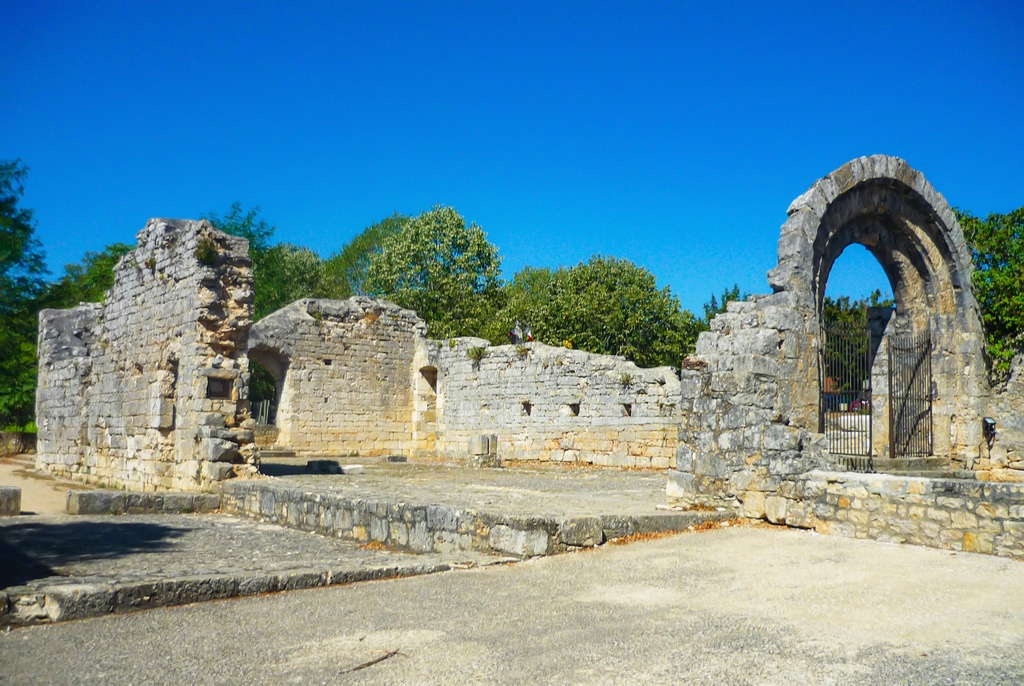
There’s also a garden, which used to be a cemetery for modest pilgrims.

Enjoy a stunning view over Rocamadour from the carpark opposite Hôtel Bellevue.
You’ll find another remarkable viewpoint on the way to the castle (route des Esclargies).

The Voie Sainte
The “Sacred Way” connects the small village of L’Hospitalet to Rocamadour.
It offers great views of the shrine’s site, with the Bishop’s Palace sitting atop the cliff.

The Porte de l’Hôpital marks the entrance to L’Hospitalet.



The Voie Sainte continues through the medieval town via the main street, past the Fig Tree and Salmon Gates, until it reaches the Great Staircase to the left.
The Sanctuaries and the Seven Chapels

Porte Saint-Martial marks the entrance to the Sanctuaries, whether you come down from the Way of the Cross or the lift station linking with Porte Salmon in the Lower Town.

From the village (or Lower Town), you can reach the Sanctuaries by climbing the Great Staircase of the pilgrims.
The Sanctuaries’ motto – “Hope as firm as a rock” (“L’espérance ferme comme le roc”) – marvellously illustrates the breathtaking situation of the religious village resting against the cliff.
Let’s go under the Saint-Martial gate and reach the Shrine.

The shrine comprises eight sanctuaries: one church (a basilica), six chapels and a crypt.
Chapelle Notre-Dame
This chapel under the cliff lies at the heart of the shrine. It marks the final stage of the pilgrimage to Rocamadour.
The shrine’s most important object of pilgrimage is the Black Virgin of Rocamadour.
Pilgrims have revered it for nearly a thousand years.


This Romanesque statue in walnut wood dates from the 12th century and measures 69 cm high.
The Virgin is depicted in a hieratic seated position with the child Jesus on her left knee (although not touching him).
Around the statue is a multitude of pilgrims’ ex-votos honouring Mary: models of boats, a painter’s palette, prisoners’ chains, cripples’ walking sticks and paintings.
See the rusty chains hanging on the wall?
Pilgrims used to put them on during penitential ceremonies!

Also in the chapel is an ancient bell (9th century) hanging from the vault.
It rang itself each time a miracle occurred.
For instance, sailors who were lost at sea prayed to the Black Virgin of Rocamadour.
In 1476, a piece of rock fell from the cliff and destroyed the sanctuary.
The bishop of Tulle, Denys de Bar, had it rebuilt in Flamboyant Gothic.
Notice the 13th-century fresco on the outside wall of the chapel.
Almost intact, it represents a macabre dance.


The priest celebrates Mass in the chapel on Saturday at 11 am.
Chapelle Saint-Michel
Half troglodytic, St. Michael Chapel is the highest sanctuary of the shrine and the closest to the sky.
It has neither a roof nor a western wall, as the chapel was carved into the rock.
In fact, pilgrims in the Middle Ages did not have access to the chapel, which was strictly devoted to Benedictine monks.
A 13th-century painting decorates the semi-dome apse.
It depicts Christ in glory, with the four Evangelists writing the Gospel, St. Michael on the left weighing the souls, and Seraphim on the right welcoming them to heaven.
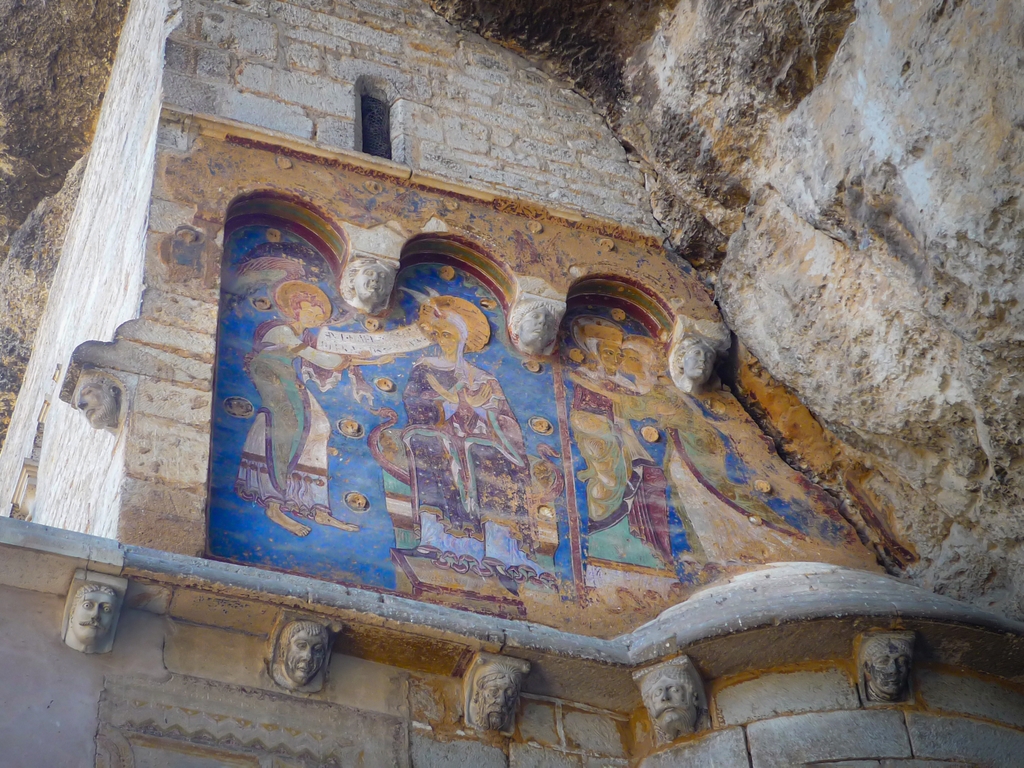
The exterior wall facing the Notre Dame Chapel has kept two interesting frescos.
On the lower part of the wall is half of a polychromed fresco depicting St Christopher.
Further above, a remarkable fresco represents “The Visitation and the Annunciation”.
This masterpiece, probably dating back to the 13th century, is in exceptional preservation.
Some guides claim that no one has ever restored it, and whether this is true or not, the fresco is definitively protected from the wind and rain thanks to the overhanging cliff.
Chapelle Saint-Louis
Originally dedicated to King Saint Louis, who came as a pilgrim to Rocamadour, the chapel is now dedicated to rugby players, where prayers are said for the injured or the deceased during or after a game.

In addition, it houses a copy of Notre-dame-du-Rugby (Our Lady of Rugby)—the original is in Larrivière-Saint-Savin in the Landes.
Rugby players donated the jerseys on display in honour of the Virgin.
Chapelle Saint-Jean-Baptiste
Initially a funeral chapel, it kept its Gothic portal from the 15th century, to which a tympanum was later added, representing the Lamb of God who takes away the sins of the world.

The chapel served as a baptistery since the 19th century.
Interestingly, the chapel’s octagonal shape and baptistery refer to the Sunday Resurrection of Christ, which occurs on the day after Shabbat, the seventh day of the week: 7+1=8.
The walls are covered with portraits of a few illustrious pilgrims who came here: Roland, King Louis IX, and his mother, Blanche of Castille.
Chapelle Saint-Blaise
The elegant bell tower of the shrine topped the St. Blaise chapel.

During the Hundred Years War, defenders of the Sanctuaries used the western window as a surveillance point above the Great Staircase.
Inside, an icon of Christ is contemplated.
The chapel is also called “Chapelle de la Divine Miséricorde” (Chapel of the Divine Mercy).
Chapelle Sainte-Anne

The stained glass from the 19th century depicts the Virgin as a young maid with her parents, St. Anne and St. Joachim and the dove of the Holy Spirit looking after her.
The Baroque altarpiece from the end of the 17th century originally belonged to the Notre Dame Chapel.
On the chapel walls are photos of engravings showing the shrine’s ruins after the French Revolution.
Crypte Saint-Amadour
The crypt dates back to the 12th century and was built in a simple Romanesque style to enlarge the terrace and support the upper church, the present-day basilica.
A two-metre cross springer separates two ribbed bays of unequal size.
Diagonal arches lacking a central keystone also support the slightly pointed vault.
Over four centuries, the crypt sheltered the allegedly intact body of St. Amadour (remember the Protestants burnt it down during the Wars of Religion!)
Nowadays, the crypt welcomes religious services every day from Monday to Friday at 11 am.
Basilique Saint-Sauveur
This is the largest sanctuary of Rocamadour.
It received its Basilica rank in 1913.
Backed against the cliff, the church was built in the 13th century in late Romanesque style.
Inside, the cross-ribbed vaulting is of Gothic style.

In fact, the crypt underneath completely supports the choir gallery.
The western wall incorporates the cliff, whereas the eastern side is orientated towards the sun’s rising.
In the 19th century, architects placed a new wooden mezzanine to accommodate more pilgrims.

The basilica is divided in two by pillars.
In fact, in the Middle Ages, one part of the nave was a shelter for the pilgrims while the other welcomed the clerics.
Above the altar, the wooden polychrome statue of Christ dates back to the 16th century.
Today, the sanctuary is Rocamadour’s parish church. It hosts a mass on Sunday at 11 am.
The Parvis
At the end of the Great Staircase, the parvis is at the centre of the shrine as it leads to the seven sanctuaries.


The parvis has, in fact, two levels:
- the lower part (access through the St Martial Gate and the Great Staircase), and
- the upper part (access to the Notre Dame and St. Michel Chapels and the Basilica).

In addition, the upper part of the Parvis also features an important site: the empty tomb, where people presumably found the intact body of St. Amadour.
Look down; you’ll see all the coins the tourists throw!
Also, don’t leave the upper part without searching for the Durandal Sword!
The Durandal Sword

Can’t see it? The famous Durandal sword is thrust into the cliff wall above the exit of Notre Dame Chapel.
Legend has it that it once belonged to Charlemagne‘s paladin and nephew Roland.
According to the Song of Roland, an angel brought the sword to Charlemagne, who in turn entrusted it to Roland.
With the help of the mighty sword, Roland held off a Saracen army of 400,000 soldiers, allowing Charlemagne to retreat into France.
At the Battle of Roncevaux Pass, Roland knew he was doomed.
Therefore, to prevent his sword from falling into enemy hands, he attempted to destroy it.
By smashing it into the cliffs, he cut the Brèche de Roland.
(Today, a natural gap in the steep cliffs of the Cirque de Gavarnie in the Pyrenees marks the border between Spain and France).
However, his attempt failed, as Durandal proved indestructible. Desperate, Roland called upon Archangel Michael for help and threw it towards the valley.
Therefore, Durandal miraculously flew 275 km before landing on the cliff wall of Rocamadour.

However, it seems that the monks of Rocamadour created that story in the 12th century.
Whether true or not, the fragment of the rusty sword is still visible today, embedded in the cliff.
The Bishop’s Palace

The Bishops Palace (Palais des Évêques) flanks the shrine looking above the valley.
True, it does look like a fairy-tale castle with its turrets and crenellations.
Nevertheless, this is a rather new addition to the site as architects heavily restored it in the 19th century.
The Chemin de Ronde
To the right of Porte Sainte (that leads up to the shrine) is the entrance to the chemin de ronde.
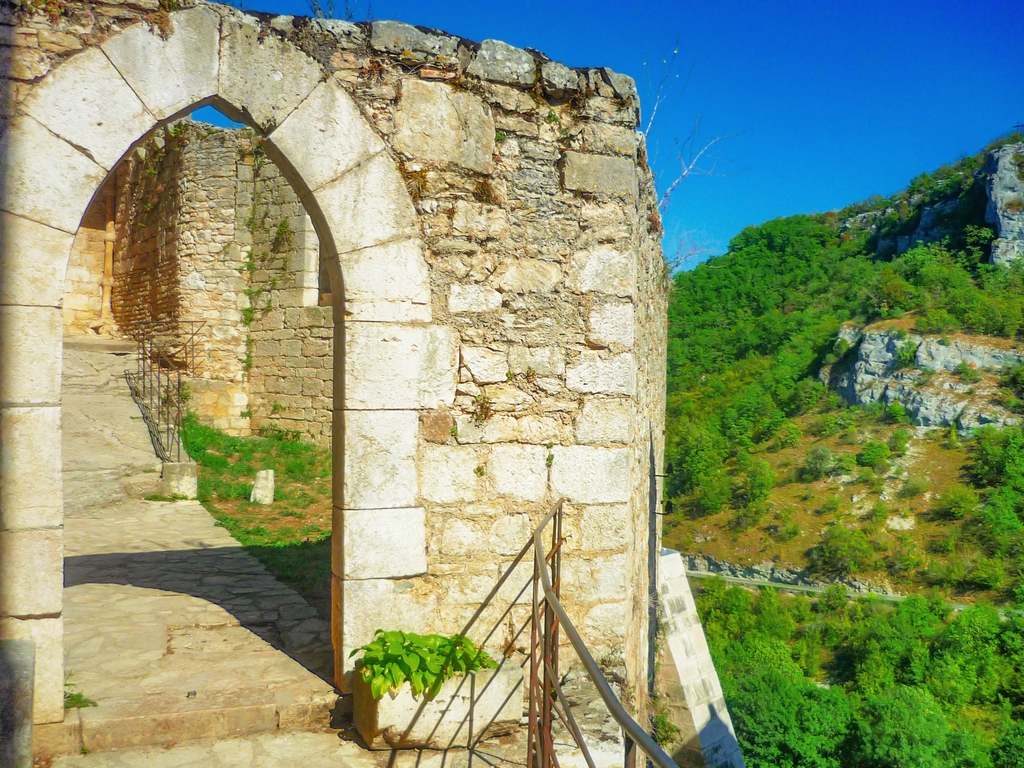
The protected and covered walkway runs along the bottom of the fortified basilica, where guards used to make their rounds.
Linking the gates of Porte Sainte to Porte Saint-Martial, it offers great views over the Alzou Valley.


The Great Staircase
From the main street of Rocamadour, the Great Staircase (l’Escalier des Pèlerins) leads to the Parvis of the Sanctuaries.


However, whether a pilgrim or a tourist, you must climb the 216 steps to reach the shrine.
In fact, during the Middle Ages, the pilgrims had to climb it on their knees in penance and stop on each step to pray! Pfew!

The last flight of stairs goes under the buildings of the Bishop’s Palace and comes out directly into the Parvis.
This porch’s name is “Porte Sainte” (Holy Gate).


The village of Rocamadour
After visiting the Holy Shrine, let’s wander in the old streets of the village…
If you don’t pay too much attention to the inevitable souvenir shops, you might enjoy discovering the medieval heritage of the ancient town.

Rue de la Mercerie
Starting from the Shrine and going westward, this old street of Rocamadour runs between the cliff face and terraced gardens to the 13th century Cabillière Gate.

Bordering the street is the Pommette, a fine house from the 13th century restored in the 15th century.
The ground floor, with its arcades, used to house a shop. The second floor features a fine mullioned window.

From the street, the castle’s ramparts on top of the cliff face can be seen.
Embedded in the rock, the Maison à Marie (Mary’s House) is inaccessible to the public.
This former Welcome Centre for pilgrims was built towards the end of the 19th century on the foundations of the monks’ dwellings.

The main street
The Fig Tree Gate (Porte du Figuier) marks the entrance to the village when coming down from L’Hospitalet via the Voie Sainte (Sacred Way).

The village’s only main street (Rue de la Couronnerie followed by Rue Roland le Preux) is one kilometre long.
Many stone houses border the street with thick external walls on the riverside.
They used to protect the village from invaders.

Rue Roland le Preux, which has souvenir shops and cafés, leads to the picturesque Salmon Gate (Porte Salmon).
This half-timbered gate controlled access to the central part of the village.

Rue de la Couronnerie continues toward the Tourist Information Centre, the Town Hall and the Great Staircase, climbing to the Sanctuaries.
The Town Hall
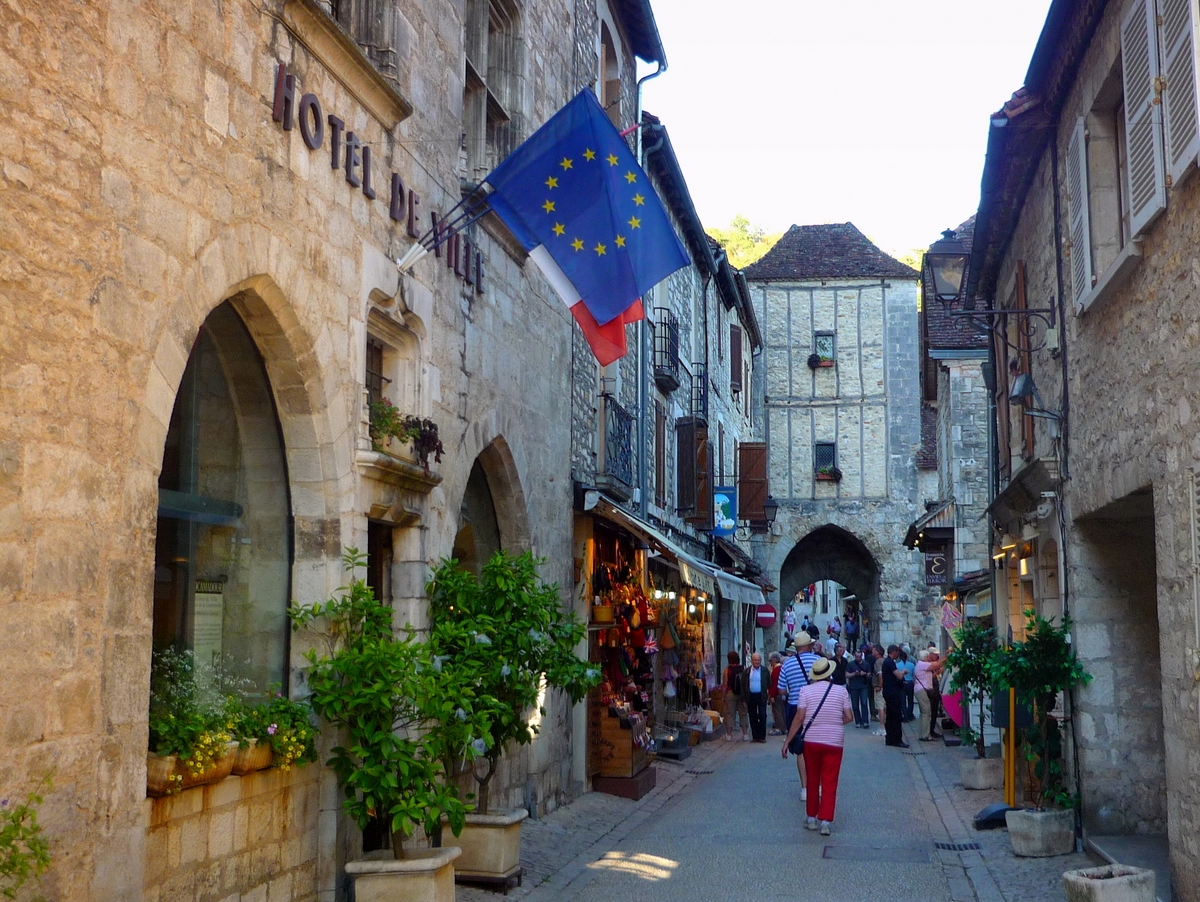
The Town Hall occupies a fine Renaissance house: “la Couronnerie” (i.e. the House of the Monks).
The Council Room displays tapestries by Jean Lurçat.
The town hall’s roof and its staircase tower are made up of lauzes (flat dried stones).
You can see it alongside the typical chimneys from the Chemin de Ronde, which runs between the Shrine and the St. Martial Gate.
The medieval town’s tourist appeal is undeniable, and, as at Mont-Saint-Michel, a large number of souvenir shops are found along the main street.
The Tourist Information Centre, situated along the street, welcomed more than 200,000 visitors in 2012.

Further on, the street is then punctuated by two gates:
The Hugon Gate (Porte Hugon)

The Lower Gate (Porte Basse)


The Roquefraîche Watermill
At the very end of the village stands the fortified watermill of Roquefraîche (12th century), built on the shores of the Alzou River with a keep tower.
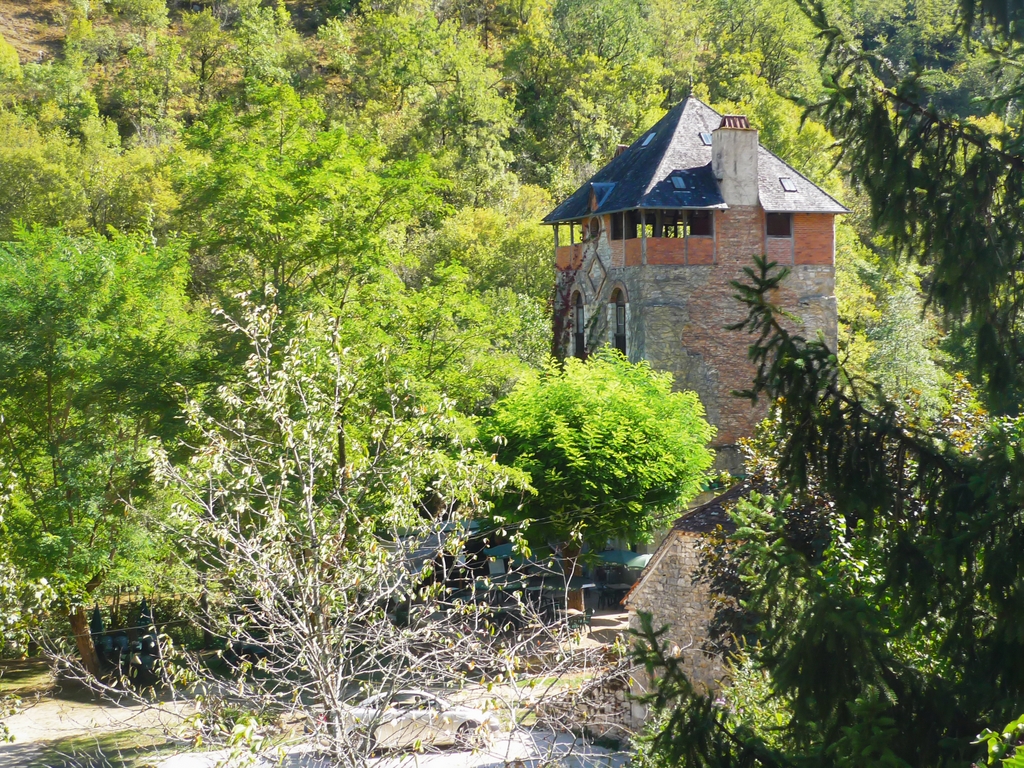
The Bishops Castle
Hanging above the cliff at the plateau, the Bishops Castle commands a strategic situation, guarding the Shrine below.
If walking up the steep hill doesn’t bother you, you can access it by the Stations of the Cross.
The Chemin de Croix

The 14 Stations of the Cross winds through the woods to the Cross of Jerusalem.
Access from the Porte Saint-Martial.
Shrines at every bend of the way represent scenes from the Passion of Christ.
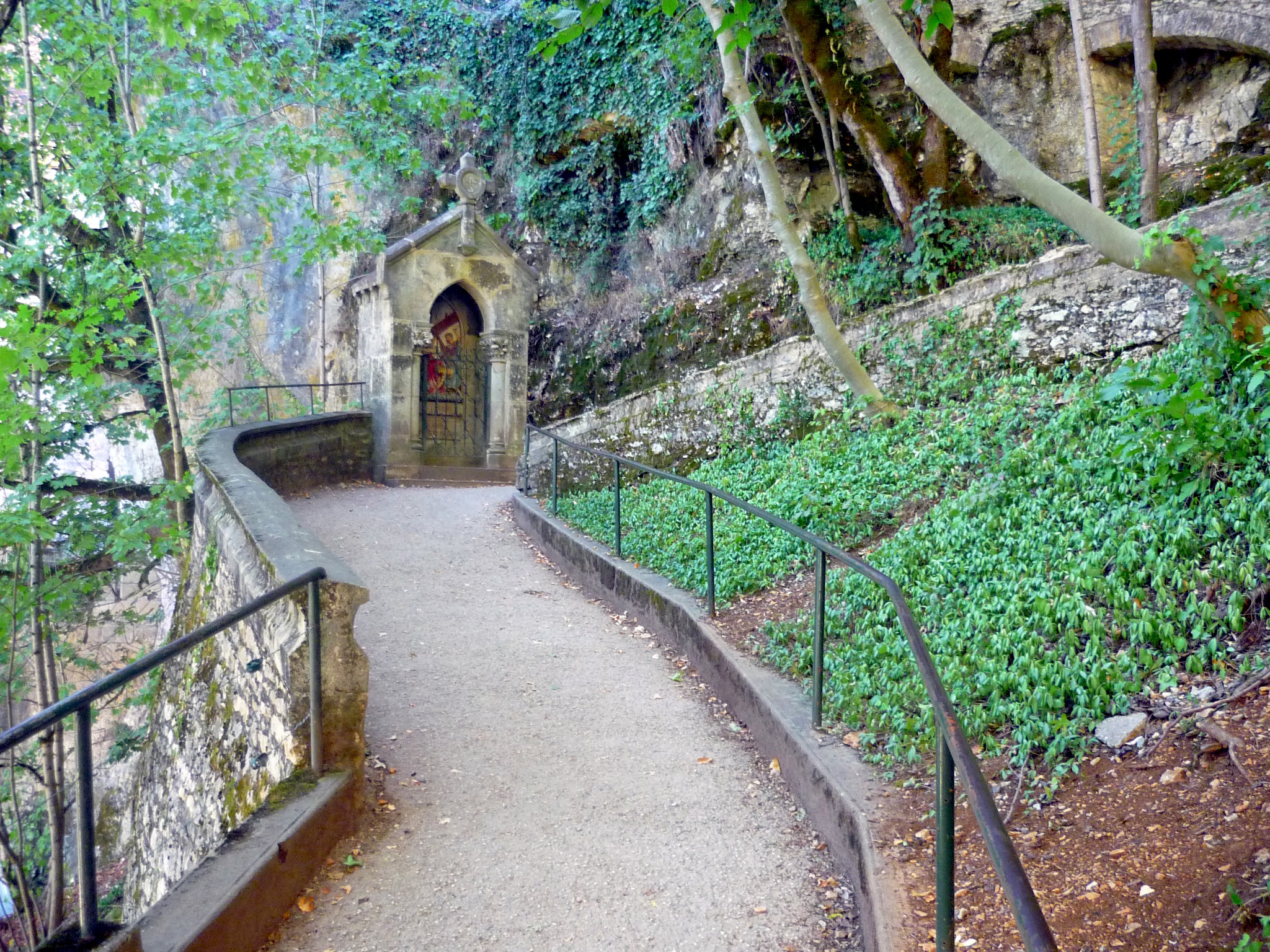
Towards the end of the way, a cave has been turned into a place of prayer.

Its name? Grotte du Saint-Sépulcre.
The cave that once served as a quarry today hosts the last stage of the Way of the Cross.

There are numerous spots with amazing views of the valley.

The Cross of Jerusalem marks the end of the ascent.
According to the legend, pilgrims brought it from Palestine.

A lift connects Porte Saint-Martial to the Castle, avoiding the steep ascent of the Way of the Cross.
The Bishops Castle
Built on top of the cliff, the castle of the bishops of Tulle was restored in the 19th century.

In 1836, Abbot Caillau bought the castle ruins to build the “château.”
It served as a welcoming place for priests on a pilgrimage.
Only the ramparts remain of the 14th-century fortress that defended the shrine below.
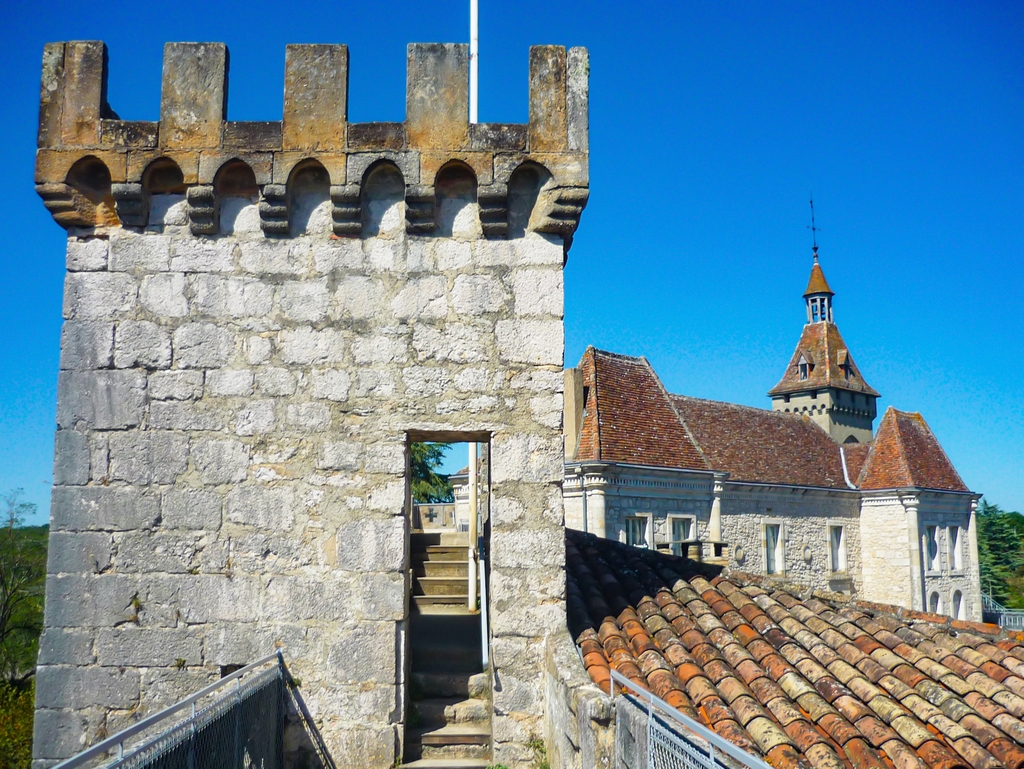
It is possible to walk atop the walls with vertiginous views of the village’s roofs, the vast deserted plain of the Causse of Gramat and 150 metres down to the Alzou River.



Other photos of Rocamadour












Rocamadour Cheese

The medieval village has given its name to a goat’s milk cheese produced in the Périgord and Quercy.
The small cheese with an average weight of 35 g has a flat, round shape.
It is usually enjoyed very young (after 2 weeks of ageing) on hot toast or in salads.
It has benefited from an AOC label (Appellation d’Origine Contrôlée) since 1996.
Plan your visit to Rocamadour: Practical Info
Here’s some information to organise your next visit to the Suspended Holy City!
Where to stay?
There is a plethora of accommodations to choose from, which is no surprise as Rocamadour is one of France’s most visited sites.
This affiliate link will direct you to a region’s accommodations list.
You can also navigate through the following map – zoom in/zoom out/go left and right to make the accommodation appear.
Things to do
Click on the following image to access a list of things to do in the Quercy-Dordogne Valley.
Tourist info from the Visitor’s Centre
The Tourist Board‘s website provides more practical information about the medieval village and the Dordogne Valley.
How to get to Rocamadour

By air
The closest airport is Brive-Vallée de la Dordogne, 40 km from Rocamadour.
Flights operate from Paris-Orly, London-City, Amsterdam, Maastricht and Ajaccio with Ryanair and EasyJet.
Other major regional airports are Toulouse-Blagnac (164km) and Bordeaux-Mérignac (270 km).
By train
From Paris Austerlitz station, trains depart regularly in the direction of Toulouse.
At Brive-la-Gaillarde (45 min) or Figeac (35 min), change trains for Rocamadour.
The station is located 5 km from the village and there is no bus service.
By car
Drive south from Paris (530 km) on the A10 to Orléans, A71 to Vierzon and A20 to Souillac.
From Toulouse (163 km), drive north on the A62 to Montauban and on the A20 to exit number 56 north of Labastide-Murat.
You will reach Rocamadour on the D32, offering you an unforgettable view of the village and its towering cliff.
Carparks
The impressive medieval village is visible from the open field of the car park.
It is located at the bottom of the Alzou Valley, near the picturesque bridge of Pont de Lafajadou.
Next to the car park is the starting point for the little train that leads visitors up to the Porte du Figuier in the Lower Town.

In addition, a large car park is situated at the top of the village, by the Bishops Castle (Parking du Château).
Two lifts connect the plateau’s top with the village in the valley, so you won’t have to climb up or down the steep hill if you don’t fancy it!
English-French Vocabulary
(f) for féminin, (m) for masculin, (adj) for adjective and (v) for verbs
- abbey = abbaye (f)
- abbot = abbé (m)
- basilica = basilique (f)
- bishop = évêque (m)
- Black Virgin = Vierge Noire (f)
- carpark = parking (m)
- castle = château (m)
- cave = grotte (f)
- chapel = chapelle (f)
- cheese = fromage (m)
- christian = chrétien (m)
- Christendom = Chrétienté (f)
- church = église (f)
- Citadel of Faith = Citadelle de la Foi (f)
- cliff = falaise (f)
- cross = croix (f)
- crypt = crypte (f)
- dwelling = demeure (f)
- fresco = fresque (f)
- gate = porte (f)
- hermit = ermite (m)
- house = maison (f)
- Hundred Years War = Guerre de Cent Ans (f)
- lift = ascenceur (m)
- mass = messe (f)
- mill = moulin (m)
- oratory = oratoire (m)
- palace = palais (m)
- parvis = parvis (m)
- pilgrim = pélerin (m)
- pilgrimage = pélerinage (m)
- plateau = plateau (m)
- prayer = prière (f)
- priory = prieuré (m)
- rock = roc (m)
- Sacred Way = Voie Sainte
- sanctuary = sanctuaire (m)
- shrine = sanctuaire (m)
- St. James’ Way = Chemin de Compostelle (m)
- staircase = escalier (m)
- Stations of the Cross = Chemin de Croix (m)
- statue = statue (f)
- sword = épée (f)
- town-hall = mairie (f)
- tympanum = tympan (m)
- valley = vallée (f)
- view point = point de vue (m)
- village = village (m)
- Virgin = Vierge (f)
- Wars of Religion = Guerres de Religion (f,p)
- watermill = moulin à eau (m)
- Way of the Cross = Chemin de Croix (m)
Pin it for later


And to finish with style, here’s a fantastic photo of Rocamadour by night!

The Rocamadour Quiz
Now that you’ve been reading this far, let’s test your knowledge of Rocamadour!




